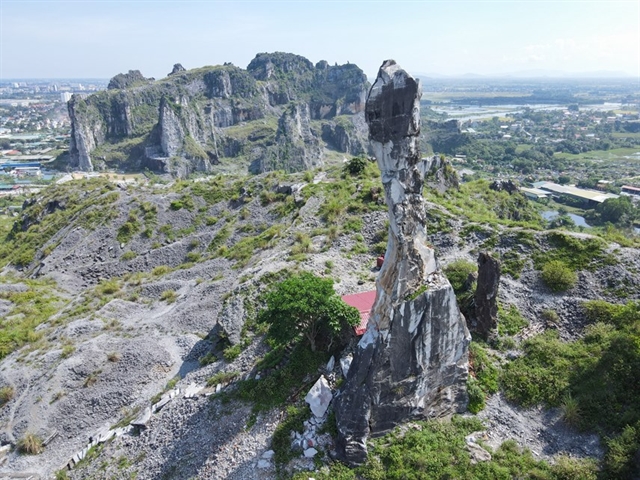
Hòn Vọng Phu (Rock Vọng Phu), part of a national heritage site in the central province of Thanh Hóa is suffering from damage after a lightning strike in 2022. Photo bvhttdl.gov.vn
Serious damage continuously caused by climate change to Việt Nam's national and world heritage in recent years has raised the alarm among authorities and experts.
Climate change, shown in the increases of temperature, rainfall, humidity, sea level and extreme weather intensity, has been identified by the United Nations Educational, Scientific and Cultural Organisation (UNESCO) as a threat to culture and heritage sites.
In Việt Nam the issue of preserving and protecting world and national heritage from climate change has been raised by experts for a long time, but over time many natural wonders are at risk of disappearing.
Most recently, lightning hit the attractive scenery of Hòn Vọng Phu (the Rock of Vọng Phu, a 20m high rock resembling the shape of a standing woman, waiting for her soldier husband, according to legend) in the central province of Thanh Hóa.
Rock Vọng Phu located on An Hoạch Mountain in Thanh Hóa City was recognised by the Ministry of Culture, Sports and Tourism as a national heritage site in 1992.
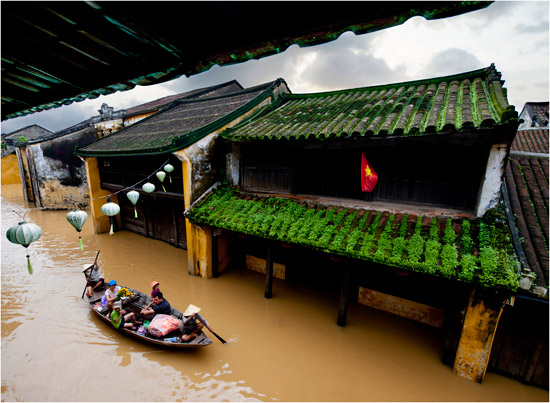
Storms and floods that occur every year have left rotten wood, damaged tiles and degraded many parts of the world heritage of Hội An Ancient Town. Photo tourconduongdisan.com
The incident occurred several times in June and August 2022, causing a landslide in the area around and serious damage to different parts of the rock.
The damage had put the rock in a very dangerous situation, and it could collapse at any time if no effective measures are taken to protect and preserve it soon, Trần Đình Thành, deputy director of the Department of Cultural Heritage of Thanh Hóa City, said.
Recently, the People's Committee [Government] of Thanh Hóa issued an official dispatch regarding a project protecting the heritage site from the impacts of natural disasters.
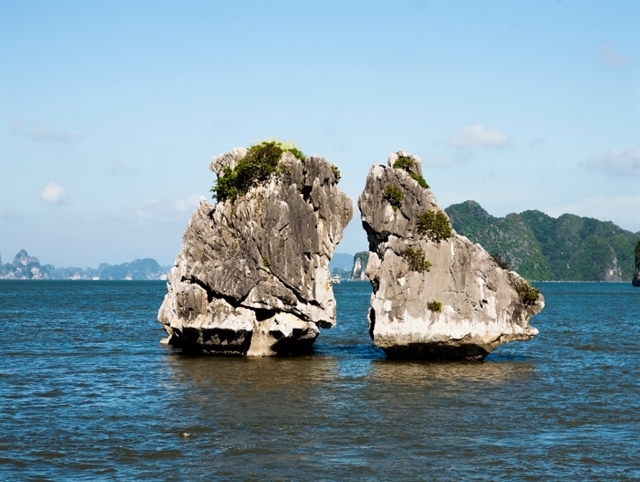
Sea erosion has also been constantly affecting Hòn Trống Mái (Kissing Rocks), the iconic rocks, emblematic of the UNESCO world natural heritage of Hạ Long Bay in the northern coastal province of Quảng Ninh. Photo halongbay.com.vn
Meanwhile, sea erosion has also constantly affected Hòn Trống Mái (Kissing Rocks), the iconic twin rocks, emblematic of the UNESCO world natural heritage of Hạ Long Bay in the northern coastal province of Quảng Ninh.
The rocks face threats due to geological processes and rising seawater levels, as highlighted by a study from the Institute of Geosciences and Mineral Resources.
Standing roughly 14m tall, the base of Hòn Trống Mái is more slender than its upper structure. Due to geological and tectonic movements, along with the influence of seawater levels, the rocks present a single-tilted structure with multiple fractures.
“There are many factors affecting Hòn Trống Mái such as waves, wind, water, tides, currents, and people,” said Hồ Tiến Chung, head of the Tectonic and Geomorphology Department of the institute.
In 2016, the 'head' of the renowned Thiên Nga (Swan) islet in Hạ Long Bay detached and plummeted into the sea.
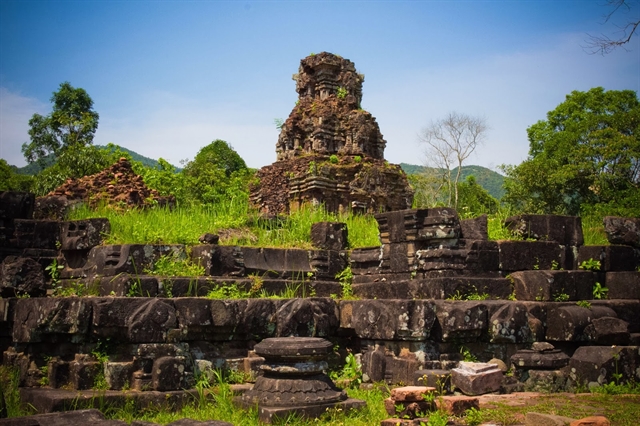
Mỹ Sơn Sanctuary, the UNESCO world heritage site has been seriously damaged by climate change. Photo vietnamheritage.com.vn
To counteract the corrosion at the base of the rocks, the institute's experts have suggested implementing technical solutions. Moreover, they recommended that the Hạ Long Bay management board should introduce measures to regulate the movement of tourist craft. This would involve controlling the speed of ships and boats near the rocks and educating local fishermen to refrain from operating around the rocks.
At present, Việt Nam has nine UNESCO heritage sites: Hạ Long Bay in Quảng Ninh, Hạ Long Bay-Cát Bà Archipelago in Quảng Ninh Province-Hải Phòng City, Phong Nha-Kẻ Bàng National Park in the central province of Quảng Bình, Huế Monuments Complex in the ancient city of Huế, Hội An Ancient Town and Mỹ Sơn Sanctuary in the south central province of Quảng Nam, the Central Sector of the Imperial Citadel of Thăng Long – Hà Nội, the Citadel of Hồ Dynasty in Thanh Hóa, and Tràng An Landscape Complex in Ninh Bình Province.
Studies by the Institute of Meteorology, Geology and Physics of Innsbruck University, Austria, 10 years ago pointed out that seven of the sites had suffered from climate change, especially the Huế Monuments.
Storms and floods left rotten wood, damaged tiles and degraded the site. The Huế Monuments Conservation Centre has continuously tried to reinforce the foundation and embankment at damaged areas.
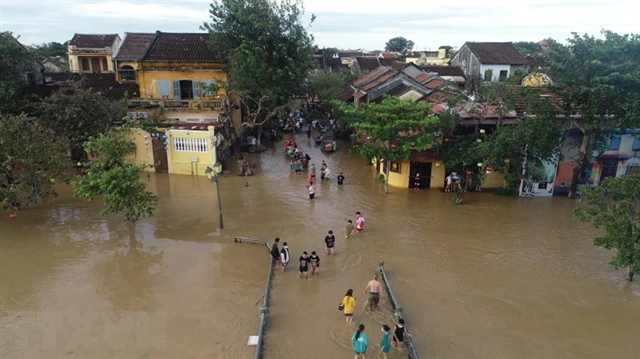
The UNESCO world heritage of Hội An Ancient Town in a flood season. VNA/VNS Photo Văn Dũng
The heritage of Hội An Ancient Town has a similar fate. As a major part of the town's architecture includes many ancient wooden houses, which are regularly subject to flooding, the situation is worsening as storm surges increase.
High sea levels cause flooding, hinder drainage, increase underground water levels, and negatively affect the stability of building foundations.
Changes in water level and salinity also lead to changes in wet-dry cycles, salt crystallisation, and dissolution, contributing to accelerating the process of degradation of the foundations of ancient structures.
Speaking at a workshop held to assess the situation at Rock Vọng Phu, Director of the Institute of Mineral Geology Trần Tân Văn, an expert with many years of experience in consulting the World Heritage and UNESCO Global Geopark, said that though such heritage sites were natural phenomena, human impact contributed to affecting them in many negative ways.
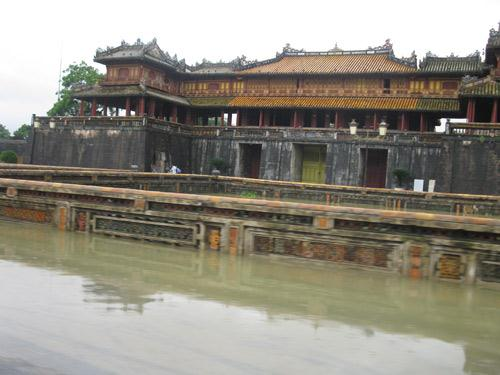
The UNESCO world heritage of the Huế Monuments Complex in the former royal capital city of Huế is heavily impacted by floods every year. Photo tourconduongdisan.com
The expert took the Kissing Rocks as a typical example, saying that the problem of tourist exploitation and allowing ships to visit them at close quarters with high frequency had created stronger water waves and added erosion.
The process of corrosion and collapse is an incredibly long process, according to Văn, but in today's times, climate change is becoming increasingly evident due to specific manifestations such as natural disasters, which are increasingly strong in intensity and erratic in frequency.
"These factors aggravate and accelerate the collapse of natural heritage sites," Văn said
"It's time for professionals and managers to take immediate and long-term measures and no longer fall into a passive situation of 'losing it before we think about recovery'." VNS

Tourists visit the ancient citadel in Huế City. VNA/VNS Photo Tường Vi
OVietnam